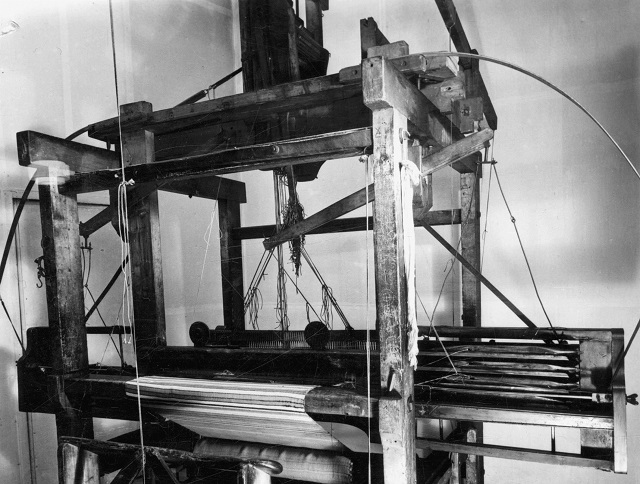Darwen's Last Hand-Loom Weaver
Handwritten
Notes of an Article Published
in the
Darwen
Gazette December 30th 1911

Mr. Edward Eccles at his Loom
Mr Edward Eccles, the only
surviving hand loom weaver, lives in the Chapel’s District. People are still
living who have been hand loom weavers, but he is the only one who is still
engaged in the craft.
Chapel’s is the oldest part
of Darwen. Hand loom weaving flourished here in olden days.
Edward Eccles’ father died
eight or nine years ago at the age of 92. His grandfather and great grandfather
before him had also been weavers or “chapmen”. (An “Eccles” is mentioned as a
“chapman” as early as 1720).
When the “Darwen Gazette”
reporter visited Mr Eccles he was weaving a piece of mauve coloured silk in a
loom house attached to an old farm close to St James’ Church. The loom, which
is over one hundred years old, is a capable and perfect piece of mechanism and
the quality of work delightful.
The silk, of the finest
Macclesfield material, not half and half as is now normal usage (1911) belonged
to an earlier day when only the very best was included in our grandmother’s
wardrobes.
After showing the working of
the loom and some of the appliances required in a self-contained loom house
conversation turned upon the olden days in Chapels and District.
At one time this locality
was the special abode of a little community of silk weavers. Apart from a few
colliers and quarrymen and a few print workers there was no-one else in the
whole of the Darwen valley.
There were two or three
places in the town where the work was given out to the workers. At that time the
only textile woven was silk. There was little woollen at any time. It was only
on the arrival of cotton and the power loom that silk was ousted from its pride
of place.

An Old Handloom
With the introduction of
cotton, a change took place in people’s tastes. Few were inclined to pay the
price that was asked for by the merchants from Macclesfield who bought up the
pieces in Darwen. Mr Eccles stated that 50, 60 or 70 years ago the price for a
yard of silk was 5/- and the weaver was paid about 10/- per week. Great were
the efforts put forward on many occasions in order to “down their cuts” in time
for Monday, which was the day they had to carry their pieces down into the town
and settle with their employers.
Sometimes his father worked
until midnight on Saturday night and started at midnight on Sunday night in
order to be in time. Weavers never
worked on Sunday; they kept the Sabbath very strictly.
The chapmen used to get
their weft and warp on Monday, play the rest of the day and also Tuesday, then
hurry the work towards weekend. Many candles were burned in order to get the
pieces out in time. Mr Eccles used to use a primitive kind of candlestick which
was hooked on to the front of the loom. He estimated that many thousands of candles
had burned in the somewhat crude contrivance.
Many of the old things still
retained within the family are rarely to be found outside the textile museums.
There were old contrivances for winding bobbins and for sizing warps, as well
as rare specimens of cane, copper and steel rods.
One interesting point
mentioned by Mr Eccles is worth recording as showing that the old timers were
not without very great ingenuity in their first efforts at weaving.
He stated that recently a
gentleman who had an invention which aimed at obviating the necessity for
“kissing the shuttle” called upon him to show him an up to date device,
whereupon he (Mr Eccles) turned to an old box he had in the corner of the room
and produced a shuttle made over 100 years ago with exactly the same device for
threading and holding weft.
While showing his treasures,
Mr Eccles described how people lived in “the handloom weaving days.” He was
evidently convinced in his own mind that the porridge and rough ‘keep’ of two
or three generations ago produced a finer lot of folks than did the luxuries of
the present day. His father sat at his after he was ninety one, did not require
glasses and retained his keen and alert faculties.
Mr. Eccles remembered the
riots at ‘Top Factory’ in 1826. The handloom weavers from Chapels took an
active part in smashing up what they believed were robbers of their living. His
father did not take an active part, but his uncle did. He had to live for some
time in hiding Darwen moors in order to avoid being taken by the police, who
were particularly alive in prosecuting offenders.
Mr Eccles then took the
interviewer into the house to show him some of his beautiful fabrics. Some of
the double threaded silks, he explained, sold at 7/- per yard and were now only
work by people who insisted upon having the very best in the way of dress
material.
As he spoke, the last of the
handloom weavers, grey bearded and clear eyed, lovingly handled the soft rich
materials.
Transcribed by Community
History Volunteer June Riding
back to top

